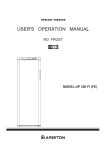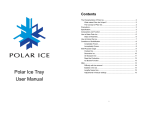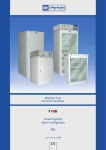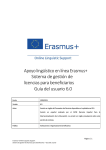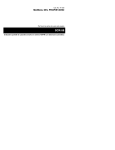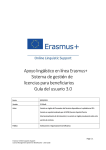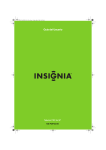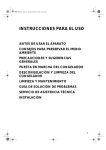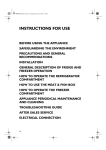Download FRIGORÍFICO DE 2 PUERTAS MANUAL DE INSTRUCCIONES
Transcript
FRIGORÍFICO DE 2 PUERTAS NVR-4353 DD MANUAL DE INSTRUCCIONES Leer las instrucciones antes de su uso y guardar para posteriores consultas 1 ES INSTRUCCIONES DE USO ANTES DE USAR EL APARATO PRECAUCIONES Y RECOMENDACIONES GENERALES CÓMO OPERAR EL COMPARTIMIENTO FRIGORÍFICO CÓMO OPERAR EL COMPARTIMIENTO DE BAJA TEMPERATURA CÓMO DESCONGELAR Y LIMPIAR EL REFRIGERADOR CUIDADO Y MANTENIMIENTO GUÍA PARA SOLUCIONAR PROBLEMAS DE INSTALACIÓN SERVICIO POST-VENTA PRESERVACIÓN DEL MEDIO AMBIENTE 2 ANTES DE USAR EL APARATO • Su nuevo aparato está diseñado exclusivamente para uso doméstico. Para un mejor uso de su aparato, lea atentamente el manual de usuario que contiene una descripción del aparato y consejos sobre el almacenamiento y la conservación de los alimentos. Guarde este manual para consultarlo en el futuro. 1. Después de desembalar, asegúrese de que el aparato no esté dañado y que la puerta se cierra correctamente. Cualquier daño debe ser notificado al concesionario antes de 24 horas después de la entrega del aparato. 2. Espere por lo menos dos horas antes de encender el aparato con el fin de asegurar que el refrigerante circuito es totalmente eficiente. 3. Instalación del aparato y eléctrico conexiones deben ser realizadas por un técnico cualificado electricista, de acuerdo con el fabricante de instrucciones y normas de seguridad locales 4. Limpie el interior del aparato antes de utilizarlo. PRECAUCIONES Y RECOMENDACIONES GENERALES • Utilice el compartimento frigorífico sólo para conservar alimentos y bebidas frescas y usar el congelador únicamente para conservar productos congelados, congelar alimentos frescos y producir cubitos de hielo. • Durante la instalación, asegúrese de que el aparato no se dañe el cable de alimentación. • No almacene envases de vidrio con líquidos en el congelador; podrían explotar. • No coma cubitos de hielo ni polos inmediatamente después de sacarlos del congelador, ya que pueden causar quemaduras por frío. • Antes de reparar o limpiar el aparato, desenchúfelo de la red eléctrica o desconecte el suministro de energía eléctrica. • Asegúrese de que el aparato no esté cerca de una fuente de calor. • No guarde ni use gasolina, gas o líquidos inflamables cerca del aparato ni de otros aparatos eléctricos. Los vapores pueden crear un peligro de incendio o explosión. • Para garantizar una ventilación adecuada, deje un espacio en tanto parte posterior e inferior del aparato y seguir las instrucciones de instalación. • Mantenga los orificios de ventilación del aparato. • Instale y nivele el aparato sobre un piso fuerte para que soporte su peso y en una zona adecuada para su tamaño y uso. • El aparato debe ser manejado e instalado por dos o más personas. • Coloque el aparato en un lugar 3 seco y bien ventilado. El aparato está previsto para el funcionamiento a temperaturas ambiente indicadas, de acuerdo con la clase climática indicada en la placa de datos: El aparato puede no funcionar correctamente si se deja durante un largo período a una temperatura por encima o por debajo del rango indicado. • Tenga cuidado de no dañar el pavimento cuando se mueve el aparato (por ejemplo, suelo de parquet). • No utilice dispositivos mecánicos, eléctricos o químicos que no sean los recomendados por el fabricante para acelerar el proceso de descongelación. • No dañe las tuberías del circuito de frío del frigorífico. • No utilice ni coloque aparatos eléctricos dentro de los compartimentos si no son del tipo que expresamente autorizado por el fabricante. • Este aparato no está diseñado para ser utilizado por niños pequeños o personas con discapacidades y sin supervisión. • Para evitar el riesgo de que los niños queden atrapados y morir asfixiados, no permita que los niños jueguen o se esconden en el interior del aparato. • Modificación del cable de alimentación o el cambio sólo deben ser realizadas por personal cualificado. • No utilice varios adaptadores individuales / o cables de extensión. • Debe ser posible desconectar el aparato de la red eléctrica desenchufando o por medio de un interruptor bipolar instalado la línea ascendente de la toma de corriente. • Asegúrese de que el voltaje indicado en la placa de características corresponde a la tensión de alimentación interna • No ingiera el contenido (no tóxicos) de los paquetes de hielo (si existe). • El fabricante declina cualquier responsabilidad si no se respetan las recomendaciones y precauciones anteriores. COMO UTILIZAR EL COMPARTIMENTO FRIGORÍFICO Conectar el aparato Puesta en marcha del aparato El aparato cuenta con controles internos. Enchufe el aparato. Cuando el aparato está conectado a la red eléctrica, la luz en el interior enciende cada vez que la puerta se abre. El termostato, que se encuentra en el interior del compartimiento del refrigerador, se utiliza para ajustar la temperatura tanto del compartimento frigorífico y compartimiento del congelador (si está instalado). 4 Ajuste de la temperatura: El termostato se utiliza para ajustar automáticamente el interior la temperatura del compartimiento del refrigerador y del compartimiento congelador. El mando del termostato se puede activar desde posición 1 a 7 (ajuste más frío) para que la temperatura interior más frío. Cuando se ajusta a O el aparato está apagado. Para almacenar los alimentos durante un corto período de tiempo, ponga el termostato entre 1 (Min) y 3 (Med). - Para almacenar los alimentos durante largos períodos de tiempo en el compartimento, ajuste el termostato a 3 ó 4. Nota: Para garantizar un funcionamiento correcto, con una temperatura ambiente inferior a 16 ° C, pulse el botón que se encuentra cerca del termostato (si está disponible). Pulse el botón de nuevo para desactivar esta opción con mayor temperaturas ambiente (por encima de 16 ° C). La temperatura del aire ambiente, la frecuencia de apertura de la puerta y la posición del aparato puede afectar a las temperaturas internas. Estos factores deben ser tenidos en cuenta al fijar el termostato. Cómo utilizar el compartimento frigorífico Coloque la comida como se muestra en la figura. A Pescado, carne B Comida cocinada C Frutas y hortalizas D Botellas E Quesos Notas: • El espacio entre los estantes y la pared posterior del compartimento frigorífico no se debe bloquear para permitir la circulación de aire. • No coloque los alimentos en contacto directo con la pared posterior del compartimiento del refrigerador. • No coloque alimentos calientes en el refrigerador. • Guarde los líquidos en recipientes cerrados. Importante El almacenamiento de verduras con alto contenido de agua puede causar que se forme condensación en el estante de vidrio del cajón para verduras: esto no va a afectar el correcto funcionamiento del aparato. 5 COMO UTILIZAR EL COMPARTIMENTO CONGELADOR El congelador es. Puede ser utilizado para congelar alimentos frescos. La cantidad de alimentos frescos que se pueden congelar en 24 horas aparece en la placa de características. Nota: En caso de un corte de energía, el compartimiento de baja temperatura se mantendrá una temperatura suficientemente baja para el almacenamiento de alimentos. Sin embargo, es aconsejable evitar la apertura de la puerta del compartimiento durante tales períodos. Congelación de alimentos frescos Importante • Antes de congelar, envolver y sellar los alimentos frescos en: papel de aluminio, film transparente, bolsas de plástico impermeables, de polietileno recipientes con tapas o recipientes para congelar adecuados para la congelación de alimentos. • Colocar los alimentos frescos en el compartimento superior, dejando suficiente espacio alrededor de cada paquete para que el aire circule. • Para la congelación óptima, gire el termostato en medio punto al colocar los alimentos frescos en el compartimento del congelador. • La comida será completamente congelada en 24 horas. La tabla muestra junto con el tiempo de almacenamiento máximo recomendado para los alimentos frescos congelados. En la compra de productos alimenticios congelados: • Asegurarse de que el envase no esté dañado (alimentos congelados en dañado embalaje pueden deteriorarse). Si el paquete está hinchado o tiene manchas de humedad, es posible que no se hayan almacenado en óptima condiciones y la descongelación haya comenzado. • Cuando vaya de compras, deje los alimentos congelados para el final y transportar los productos en una bolsas térmicas. • Coloque los artículos en el compartimiento de baja temperatura, tan pronto como llegue a casa. • Si los alimentos se han descongelado parcialmente, no vuelva a congelarlo. Consumir dentro de las 24 horas. • Evitar o reducir las variaciones de temperatura al mínimo. Respete la fecha de caducidad en el envase. • Observe siempre la información de almacenamiento en el envase. Cubitos de hielo • Llene la bandeja de cubitos de hielo 2/3 y colóquelo en el compartimiento de baja temperatura • No use instrumentos filosos o puntiagudos para separar la bandeja si está pegada a la parte inferior del compartimiento de baja temperatura. • Doble la bandeja de hielo ligeramente para eliminar los cubos 6 MESES ALIMENTO CÓMO DESCONGELAR Y LIMPIAR EL REFRIGERADOR Antes de realizar cualquier operación de limpieza o mantenimiento, desenchufe el aparato de la red o desconecte el suministro de energía eléctrica. La descongelación del compartimento frigorífico es completamente automática. Las gotas de agua en la pared trasera del compartimento del refrigerador indican que la fase de descongelación automática se encuentra en progreso. El agua de descongelación se envía automáticamente a una salida de desagüe hasta un contenedor desde el que se evapora. Descongelar el compartimento congelador Descongelar el compartimento congelador una o dos veces año o cuando la formación de hielo es excesiva. Es perfectamente normal que se forme hielo. La cantidad de hielo que formas y la velocidad a la que se acumula voluntad depende la temperatura ambiente y la humedad, y de la frecuencia con que se abre la puerta. La formación de hielo se concentra en el parte superior del compartimiento y no afecta a la eficiencia del aparato. Si es posible, descongelarlo cuando esté casi vacío. • Retire los alimentos del congelador, envuélvalo en papel de periódico y agrúpelos juntos en un lugar fresco o en una bolsa térmica. • Deje la puerta abierta para permitir que el hielo se derrita. • Limpie el interior con una esponja empapada en agua tibia y / o detergente neutro. No utilice sustancias abrasivas. • Enjuague el interior y seque bien. • Coloque los alimentos de nuevo en el congelador. • Cierre la puerta. • Conecte el aparato una vez más. • Conecte el aparato 7 CUIDADO Y MANTENIMIENTO • Limpie periódicamente las rejillas de ventilación y el condensador en la parte posterior del aparato con una aspiradora o un cepillo. • Limpie el exterior con un paño suave. Desuso prolongado 1. Vacíe el frigorífico. 2. Desconecte el aparato de la fuente de alimentación. 3. Descongele y limpie el interior. 4. En caso de inactividad prolongada, deje la puerta abierta para evitar la formación de moho, olores y la oxidación. 5. Limpie el aparato. • Limpie el interior del compartimiento de baja temperatura (donde hay) cuando la descongelación. • Limpie periódicamente el interior del compartimiento del refrigerador con una esponja humedecida en agua templada y / o detergente neutro. Enjuague y secar con un paño suave. No utilice productos abrasivos. • Limpie el exterior con un paño suave y húmedo. No utilice productos abrasivos, estropajos, quitamanchas (por ejemplo, acetona, tricloroetileno) o vinagre. Reemplazo de bombillas: Al sustituir la lámpara, proceda de la siguiente manera: • Desconecte el aparato de la red • Apriete las lengüetas de los lados de la cubierta de la lámpara y retírela. • Sustituya la lámpara por una nueva, máxima 10 W. • Coloque la tapa de la lámpara de nuevo y esperar 5 minutos antes de conectar el aparato de nuevo en la red. 8 INSTALACIÓN • Instale el aparato lejos de fuentes de calor. La instalación en un ambiente caluroso, la exposición directa al sol o la instalación cerca de fuentes de calor (estufas, radiadores, cocinas) aumentará el consumo de energía y por lo tanto debe evitarse. • Si esto no es posible, las siguientes distancias mínimas deben ser respetadas: • 30 cm de carbón o petróleo estufas; • 3 cm desde cocinas eléctricas y / o gas. • Colocar los separadores (si se incluye) en la parte trasera del condensador posicionada en la parte posterior del aparato (ver figura). • Para optimizar la eficiencia del aparato, deje un espacio de 5 cm por encima del aparato y asegurarse de que las unidades de cocina adyacentes están suficientemente distanciados para permitir la circulación del aire. • Instale el aparato en un lugar seco y bien ventilado, y asegúrese de que está a nivel, utilizando las patas de ajuste delanteras en caso necesario. • Limpie el interior. • Coloque los accesorios. Conexión eléctrica • Las conexiones eléctricas deben realizarse de conformidad con las ordenanzas locales regulaciones. • Tensión y el consumo de energía se indican en la placa de en el interior del aparato. • Las regulaciones requieren que el aparato está conectado a tierra. El fabricante declina toda responsabilidad por daños a personas o animales o daños a la propiedad resultantes de la inobservancia de estas regulaciones. • Si el enchufe y la toma no son del mismo tipo, que la toma de reemplazado por un electricista calificado. • No utilizar prolongaciones o adaptadores. Desconexión del aparato Debe ser posible desconectar el aparato desenchufándolo o mediante desconexión del suministro eléctrico. 9 Cambio dirección Puerta La inversión de la apertura de la puerta El refrigerador tiene la capacidad de abrir la puerta de cualquiera de 2 la izquierda o la derecha. La unidad se entrega usted con la apertura de la puerta desde el lado izquierdo. Para cambiar el sentido de apertura, por favor, siga estas instrucciones. Nota: Antes de invertir el movimiento de la puerta, desconecte el aparato de la red o desconecte el suministro de energía eléctrica. 1. Quite los tornillos (1) que sujetan el panel superior (2) a la unidad. Retire el panel superior 2. Retire los dos tornillos (3) que sujetan la bisagra superior (4) (lado derecho) para el marco. Retire la bisagra superior (4). 3. Levante la puerta del pasador de la bisagra central y colocarlo en un norayar la superficie. 4. Retire los dos tornillos (5) que sujetan la bisagra del medio (6). Retire la bisagra central (6). 5. Levante la puerta inferior del pasador de la bisagra inferior y colocarlo en un norayar la superficie. 6. Retire los dos tornillos (7) que sujetan la bisagra inferior (8). Retire la bisagra inferior (8). 7. Retire la pata delantera izquierda (9) y transferirlo a la derecha. 8. Antes de sustituir la bisagra inferior (8), quitar el pasador de la bisagra (10) y revertir la dirección de la bisagra (8). Volver a montar la la bisagra inferior (6) en el lado de la mano izquierda con los dos tornillos (7). 9. Vuelva a colocar el pasador de la bisagra (10) en la bisagra inferior (8). 10 10. Baje la puerta sobre el pasador de la bisagra inferior (10). 11. Mientras sostiene la puerta inferior en posición de cierre, volver a montar la bisagra del medio (6) en el lado de mano izquierda utilizando los dos tornillos (5). No apriete los tornillos (5) hasta que la parte superior de la puerta inferior esté a nivel con la parte superior del contador. 12. Antes de sustituir la bisagra superior (4), retirar el pasador de la bisagra (11) y revertir la dirección de la bisagra (4). Volver a colocar el pasador de bisagra (11) en la bisagra superior (4). 13. Baje la puerta superior sobre el perno de la bisagra del medio. 14. Mientras sostiene la puerta superior en la posición cerrada, volver a montar la bisagra superior (4) en el lado de mano izquierda utilizando los dos tornillos (3). No apriete los tornillos (3) hasta que la parte superior de la puerta superior está a nivel con encimera superior del frigorífico 15. Vuelva a colocar el panel superior (2) con los tornillos (1) 11 GUÍA PARA SOLUCIONAR PROBLEMAS DE INSTALACIÓN 1. El aparato no funciona. • ¿Hay un corte de corriente? • ¿El enchufe está bien insertado en la toma? • ¿Está el interruptor bipolar en? • ¿Se ha fundido el fusible? • ¿Está dañado el cable de alimentación? • ¿El termostato está ajustado en z (Stop)? 2. Temperatura en el interior de los compartimentos no es lo suficientemente baja. • ¿La puerta se cerró correctamente? • ¿Es la comida obstruyendo el cierre adecuado de la puerta? • ¿El aparato está instalado cerca de una fuente de calor? • ¿Es correcto el ajuste del termostato? • Están bloqueados los orificios de circulación de aire? 3. Temperatura en el interior del compartimento frigorífico es demasiado baja. • ¿Es correcto el ajuste del termostato? 4. El aparato es excesivamente ruidoso. • ¿Se ha instalado correctamente el aparato? • ¿Están las tuberías en la parte posterior de tocar o de vibración? 5. El agua se acumula en la parte inferior del compartimiento del refrigerador. • ¿Está bloqueado el desagüe del agua de descongelación? 6. Excesiva acumulación de escarcha en el compartimento de baja temperatura. • ¿La puerta se cerró correctamente? • ¿Es la comida obstruyendo el cierre adecuado de la puerta? 7. El aparato no funciona. • ¿Hay un corte de corriente? • ¿El enchufe está bien insertado en la toma? • ¿Está el interruptor bipolar en? • ¿Se ha fundido el fusible? • ¿Está dañado el cable de alimentación? • ¿El termostato está ajustado en z (Stop)? 8. Temperatura en el interior de los compartimentos no es lo suficientemente baja. • ¿La puerta se cerró correctamente? • ¿Es la comida obstruyendo el cierre adecuado de la puerta? • ¿El aparato está instalado cerca de una fuente de calor? • ¿Es correcto el ajuste del termostato? • Están bloqueados los orificios de circulación de aire? 12 9. Temperatura en el interior del compartimento frigorífico es demasiado baja. • ¿Es correcto el ajuste del termostato? 10. El aparato es excesivamente ruidoso. • ¿Se ha instalado correctamente el aparato? • ¿Están las tuberías en la parte posterior de tocar o de vibración? 11. El agua se acumula en la parte inferior del compartimiento del refrigerador. • ¿Está bloqueado el desagüe del agua de descongelación? 12. Excesiva acumulación de escarcha en el compartimento de baja temperatura. • ¿La puerta se cerró correctamente? • ¿Es la comida obstruyendo el cierre adecuado de la puerta? Notas: • gorgoteo y ruidos silbantes debido a la expansión en el circuito refrigerante son normales. SERVICIO POST-VENTA Antes de llamar al Servicio de Asistencia Técnica: 1. A ver si puedes resolver el problema por su cuenta con la ayuda de la "Guía de resolución de problemas"). 2. Encienda el aparato de nuevo para ver si el problema se ha resuelto. Si no es así, desconecte el aparato de la fuente de alimentación y espere aproximadamente una hora antes de encenderla de nuevo. 3. Si el problema persiste después de este curso de acción, comuníquese con el Servicio Post-venta. Especifique: • La naturaleza del problema • el modelo • el número de servicios (el número después de la palabra SERVICE en la placa de características en el interior de la aparato) • su dirección completa • su número de teléfono y código de área. 13 Nota: La dirección de apertura de la puerta se puede cambiar. Si esta operación se lleva a cabo por el servicio post-venta no está cubierto por la garantía. Información: Este aparato no contiene CFC (el circuito de refrigerante contiene R134a) o HFC (el circuito refrigerante contiene R600a) (ver la clasificación placa en el interior del aparato). Los aparatos con isobutano (R600a): Isobutano es un origen natural, bajo gas de impacto ambiental. Se debe tener precaución. Por lo tanto, asegúrese de que las tuberías del circuito de refrigeración no se dañen. Proceso correcto de desecho de este producto 14 INSTRUCTIONS FOR USE EN BEFORE USING THE APPLIANCE SAFEGUARDING THE ENVIRONMENT PRECAUTIONS AND GENERAL RECOMMENDATIONS HOW TO OPERATE THE REFRIGERATOR COMPARTMENT HOW TO OPERATE THE LOW TEMPERATURE COMPARTMENT HOW TO DEFROST AND CLEAN THE REFRIGERATOR CARE AND MAINTENANCE INSTALLATION TROUBLESHOOTING GUIDE AFTER-SALES SERVICE 15 BEFORE USING THE APPLIANCE • Your new appliance is designed exclusively for domestic use. For best use of your appliance, carefully read the user handbook which contains a description of the appliance and advice on storing and preserving food. Keep this handbook for future consultation. 1. After unpacking, make sure that the appliance is undamaged and that the door closes properly. Any damage must be reported to your dealer within 24 hours after delivery of the appliance. 2. Wait at least two hours before switching the appliance on in order to ensure the refrigerant circuit is fully efficient. 3. Installation of the appliance and electrical connections must be carried out by a qualified electrician, in accordance with the manufacturer’s instructions and local safety regulations 4. Clean the inside of the appliance before using it. SAFEGUARDING THE ENVIRONMENT 1. Packing The packaging material is entirely recyclable, and marked with the recycling symbol. Follow local regulations for scrapping. Keep the packaging materials (plastic bags, polystyrene parts, etc.) out of reach of children, as they are potentially dangerous. 2. Scrapping The appliance is manufactured using recyclable material. Correct Disposal of this product Information: This appliance does not contain CFCs (the refrigerant circuit contains R134a) or HFCs (the refrigerant circuit contains R600a) (see the rating plate inside the appliance). Appliances with Isobutane (R600a): isobutane is a naturally occurring, low environmental impact gas. Caution is required, however, because isobutane is flammable. Therefore, ensure that the pipelines of the refrigerant circuit do not get damaged. 16 PRECAUTIONS AND GENERAL RECOMMENDATIONS Climatic Class Amb. T. (°C) Amb. T. (°F) • Use the refrigerator compartment only for SN From 10 to 32 From 50 to 90 storing fresh food and beverages and use N From 16 to 32 From 61 to 90 ST From 18 to 38 From 64 to 100 the freezer compartment only for storing T From 18 to 43 From 64 to 110 frozen food, freezing fresh food and making ice cubes. • During installation, make sure the appliance does not damage the power cable. • Do not store glass containers with liquids in thefreezer since they may burst. • Do not eat ice cubes or ice lollies immediately after taking them out of the freezer since they may cause cold burns. • Before servicing or cleaning the appliance, unplug it from the mains or disconnect the electrical power supply. • Make sure that the appliance is not near a heat source. • Do not store or use petrol, gas or flammable liquids in the vicinity of the appliance or other electrical appliances. The fumes can create a fire hazard or explosion. • To ensure adequate ventilation, leave a space on both back and bottom the appliance and follow the installation instructions. • Keep the appliance ventilation openings free. • Install and level the appliance on a floor strong enough to take its weight and in an area suitable for its size and use. • The appliance must be handled and installed by two or more persons. • Place the appliance in a dry and well-ventilated place. The appliance is set for operation at specific ambient temperature ranges, according to the climatic class indicated on the data plate: The appliance may not work properly if it is left for a long period at a temperature above or below the indicated range. • Be careful not to damage the floors when you move the appliance (e.g. parquet flooring). • Do not use mechanical, electric or chemical means other than those recommended by the Manufacturer to speed up the defrost process. • Do not damage the refrigerator’s refrigerant circuit pipes. • Do not use or place electrical appliances inside the compartments if they are not of the type expressly authorized by the Manufacturer. • This appliance is not designed for use by young children or the infirm without supervision. • To avoid the risk of children being trapped and therefore suffocating, do not allow them to play or hide inside the appliance. 17 • Power cable modification or replacement must only be carried out by qualified personnel. • Do not use single/multiple adapters or extension cables. • It must be possible to disconnect the appliance from the mains by unplugging it or by means of a two-pole switch fitted up line of the socket. • Ensure that the voltage indicated on the appliance data plate corresponds to the domestic supply voltage • Do not swallow the contents (non-toxic) of the ice packs (if provided). • The Manufacturer declines any liability if the above recommendations and precautions are not respected. 18 HOW TO OPERATE THE REFRIGERATOR COMPARTMENT Switching on the appliance Starting up the appliance The appliance features internal controls. Plug in the appliance. When the appliance is connected to the mains, the inside light switches on each time the door is opened. The thermostat, located inside the refrigerator compartment, is used to adjust the temperature of both the refrigerator compartment and low temperature compartment (if fitted). Appliance temperature adjustment: Temperature setting: The thermostat is used to automatically adjust the internal temperature of the refrigerator compartment and the or compartment.. The thermostat knob can be turned from position 1 to 7 (coldest setting) to make the internal temperature colder. When set to O the appliance is switched off. To store food for a short period of time, set the thermostat between 1 (Min) and 3 (Med). - To store food for long periods of time in the compartment, set the thermostat to 3 or 4. Note: To guarantee correct operation with ambient temperatures below 16°C, press the button located near the thermostat (if provided). Press the button again to turn this off with higher ambient Temperatures (above 16°C). The ambient air temperature, frequency of door opening and the position of the appliance can affect internal temperatures. These factors must be taken into account when setting the thermostat. 19 How to use the refrigerator compartment Position the food as shown in the figure. A Fish, meat B Cooked food C Fruit and vegetables D Bottle E Cheese Notes: • The space between the shelves and the rear wall of the refrigerator compartment must be unobstructed to allow circulation of air. • Do not place food in direct contact with the rear wall of the refrigerator compartment. • Do not place hot food in the refrigerator. • Store liquids in closed containers. Important Storing vegetables with high water content can cause condensation to form on the glass shelf of the crisper drawer: this will not affect the correct operation of the appliance. 20 HOW TO OPERATE THE FREEZER COMPARTMENT The freezer compartment is. It can be used to freeze fresh food. The quantity of fresh food that can be frozen in 24 hours is shown on the rating plate. Note: In the event of a power cut, the low temperature compartment will maintain a sufficiently low temperature for food storage. However, it is advisable to avoid opening the compartment door during such periods. Freezing fresh food Important • Before freezing, wrap and seal fresh food in: aluminium foil, cling film, air and water-tight plastic bags, polythene containers with lids or freezer containers suitable for freezing fresh food. • Arrange the fresh food in the top compartment, leaving sufficient space around each pack for the air to circulate. • For optimum freezing, turn the thermostat down by half a point when placing fresh foods in the freezer compartment. • The food will be completely frozen in 24 hours. The table alongside shows the recommended maximum storage time for frozen fresh foods. When purchasing frozen food products: • ensure that the packaging is not damaged (frozen food in damaged packaging may have deteriorated). If the package is swollen or has damp patches, it may not have been stored under optimal conditions and defrosting may have already begun. • When shopping, leave frozen food purchases until last and transport the products in a thermally insulated cool bag. • Place the items in the low temperature compartment as soon as you get home. • If food has defrosted even partially, do not re-freeze it. Consume within 24 hours. • Avoid, or reduce temperature variations to the minimum. Respect the best-before date on the package. • Always observe the storage information on the package. 21 Making ice cubes • Fill the ice cube tray 2/3 full and place it in the low temperature compartment • Do not use sharp or pointed instruments to detach the tray if it is stuck to the low temperature compartment bottom. • Bend the ice tray slightly to remove the cubes. MONTHS FOOD 22 HOW TO DEFROST AND CLEAN THE REFRIGERATOR Before any cleaning or maintenance operation, unplug the appliance from the mains or disconnect the electrical power supply Defrosting of the refrigerator compartment is completely automatic. Droplets of water on the rear wall of the refrigerator compartment indicate that the periodic automatic defrost cycle is in progress. The defrost water is automatically routed to a drain outlet and into a container from which it evaporates. Defrosting the freezer compartment Defrost the freezer compartment once or twice a year or when the ice formation is excessive. It is perfectly normal for ice to form. The amount of ice which forms and the rate at which it accumulates will depends on room temperature and humidity, and on the frequency with which the door is opened. Ice formation is concentrated at the top of the compartment and does not affect the efficiency of the appliance. If possible, defrost the freezer when it is nearly empty. • Remove the food from the freezer, wrap in newspaper and group together in a cool place or in a portable cooler. • Leave the door open to allow the frost to melt. • Clean the interior with a sponge soaked in warm water and/or neutral detergent. Do not use abrasive substances. • Rinse the interior and dry thoroughly. • Put the food back into the freezer. • Close the door. • Plug in the appliance once again. • Switch the appliance on. 23 CARE AND MAINTENANCE • Periodically clean air vents and the condenser at the rear of the appliance with a vacuum cleaner or a brush. • Clean the outside using a soft cloth. Prolonged disuse 1. Empty the refrigerator. 2. Disconnect the appliance from the power supply. 3. Defrost and clean the interior. 4. In the event of prolonged disuse, leave the door open to prevent the formation of mold, odors and oxidation. 5. Clean the appliance. • Clean the inside of the low temperature compartment (where fitted) when defrosting. • Periodically clean the inside of the refrigerator compartment with a sponge dampened in warm water and/or neutral detergent. Rinse and dry with a soft cloth. Do not use abrasive products. • Clean the outside with a soft damp cloth. Do not use abrasive products, scourers, stain-removers (e.g. acetone, trichloroethylene) or vinegar. Replacing bulbs: When replacing the bulb, proceed as follows: • Unplug the appliance from the mains • Squeeze the tabs on the sides of the lamp cover and remove it. • Replace the bulb with a new one, maximum 10 W. • Put the lamp cover back on and wait 5 minutes before plugging the appliance back into the mains. 24 INSTALLATION • Install the appliance away from heat sources. Installation in a hot environment, direct exposure to the sun or installation near heat sources (heaters, radiators, cookers) will increase power consumption and should therefore be avoided. • If this is not possible, the following minimum distances must be respected: • 30 cm from coal or paraffin stoves; • 3 cm from electric and/or gas stoves. • Fit the spacers (if supplied) on the rear of the condenser positioned at the back of the appliance (see figure). • To optimize appliance efficiency, leave a 5 cm gap above the appliance and make sure that adjacent kitchen units are sufficiently distanced to allow air circulation. • Install the appliance in a dry, well-ventilated place, and ensure it is level, using the front adjustment feet if necessary. • Clean the interior. • Fit the accessories. Electrical connection • Electrical connections must be made in accordance with local regulations. • Voltage and power consumption are indicated on the rating plate inside the appliance. • Regulations require that the appliance is earthed. The Manufacturer declines all liabilities for injury to persons or animals or damage to property resulting from failure to observe these regulations. • If the plug and socket are not of the same type, have the socket replaced by a qualified electrician. • Do not use extension leads or adapters. Disconnecting the appliance It must be possible to disconnect the appliance by unplugging it or by means of a two-pole switch fitted up line of the socket 25 Door Swing Reversal Reversing the door swing The refrigerator has the capability of opening the door from either the left or the right side. The unit is delivered to you with the door opening from the left side. To change the opening direction, please follow these instructions. Note: Before reversing the door swing, unplug the appliance from the mains or disconnect the electrical power supply. 1. Remove the screws (1) holding the top panel (2) to the unit. Remove the top panel 2. Remove the two screws (3) holding the top hinge (4) (right side) to the frame. Remove the top hinge (4). 3. Lift the door off the middle hinge pin and place it on a nonscratching surface. 4. Remove the two screws (5) holding the middle hinge (6). Remove the middle hinge (6). 5. Lift the lower door off the bottom hinge pin and place it on a nonscratching surface. 6. Remove the two screws (7) holding the bottom hinge (8). Remove the bottom hinge (8). 7. Remove the left front leg (9) and transfer it to the right side. 8. Before replacing the bottom hinge (8), remove the hinge pin (10) and reverse the direction of the hinge (8). Reassemble the bottom hinge (6) on the left hand side using the two screws (7). 9. Refit the hinge pin (10) into the bottom hinge (8). 10. Lower the door onto the bottom hinge pin (10). 11. While holding the lower door in the closed position, reassemble the middle hinge (6) on the left hand side using the two screws (5). Do not tighten the screws (5) until the top of the lower door is level with the counter top. 13. Before replacing the upper hinge (4), remove the hinge pin (11) and reverse the direction of the hinge (4).Refit the hinge pin (11) into the upper hinge (4). Lower the upper door onto the middle hinge pin. 14. While holding the upper door in the closed position, reassemble the upper hinge (4) on the left hand side using the two screws (3). Do not tighten the screws (3) until the top of the upper door is level with the counter top. Door opening from left side 15. Refit the top panel (2) using the screws (1). 26 Note: The direction of door opening can be changed. If this operation is performed by After-sales Service it is not covered by the warranty. 27 TROUBLESHOOTING GUIDE 1. The appliance is not working. • Is there a power failure? • Is the plug properly inserted in the socket? • Is the double-pole switch on? • Has the fuse blown? • Is the power cord damaged? • Is the thermostat set to z (Stop)? 2. Temperature inside the compartments is not low enough. • Is the door shut properly? • Is food obstructing proper door closure? • Is the appliance installed near a heat source? • Is the thermostat setting correct? • Are the air circulation vents blocked? 3. Temperature inside the refrigerator compartment is too low. • Is the thermostat setting correct? 4. The appliance is excessively noisy. • Has the appliance been installed correctly? • Are the pipes at the back touching or vibrating? 5. Water collects at the bottom of the refrigerator compartment. • Is the defrost water drain blocked? 6. Excessive frost build-up in the low temperature compartment. • Is the door shut properly? • Is food obstructing proper door closure? Notes: • Gurgling and hissing noises due to expansion in the refrigerant circuit are normal. Before contacting After-Sales Service: 1. See if you can solve the problem yourself with the help of the “Troubleshooting guide”). 2. Switch the appliance on again to see if the problem has been solved. If it has not, disconnect the appliance from the power supply and wait for about an hour before switching on again. 3. If the problem persists after this course of action, contact Aftersales Service. 28 DECLARACIÓN DE CONFORMIDAD NEVIR, S.A. declara bajo su responsabilidad que el aparato indicado cumple los requisitos de las siguientes directivas: LVD (2006/95/EC) EN 60335-2-24:2010 EN 60335-1:2012 EN 62233:2008 EMC (2004/108/EC) EN 55014-1:2006+A1:2009+A2:2011 EN 55014-2:1997+A1:2001+A2:2008 EN 61000-3-2:2006+A1:2009+A2:2009 EN 61000-3-3:2013 RoHS(2011/65/EU) Descripciones del aparato: FRIGORÍFICO 2 PUERTAS Modelo NEVIR: NVR-4353 DD Importador: NEVIR, S.A. Dirección del importador: NEVIR, S.A. C/ Canteros, 14 Parque Empresarial Puerta de Madrid 28830 San Fernando de Henares, Madrid 29





























